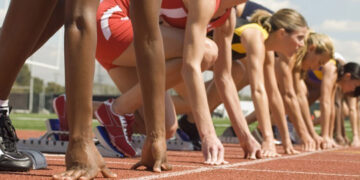Sports training has evolved dramatically over the last few decades. No longer limited to whistle-blowing coaches and stopwatches, today’s athletes benefit from a world where technology drives performance, precision, and personalization. From data analytics and wearables to virtual reality and AI-driven coaching, tech is transforming how athletes train, recover, and compete.
This blog explores how modern technology is revolutionizing sports training, making it more efficient, scientific, and tailored than ever before.
1. Wearable Technology: Real-Time Insights on Performance
Wearables have become an essential part of an athlete’s toolkit. These small, sensor-equipped devices gather vast amounts of data during training and games.
Common wearable devices include:
-
Smartwatches and fitness trackers (e.g., Garmin, Polar)
-
Heart rate monitors and chest straps
-
GPS vests worn by soccer, rugby, and football players
-
Sleep and recovery rings (like the Oura Ring)
Benefits:
-
Track distance, speed, and heart rate zones
-
Monitor sleep quality and readiness
-
Detect overtraining or fatigue risks
-
Provide recovery suggestions based on stress and strain
Real-World Example:
Elite soccer clubs use GPS vests to monitor players’ sprint counts, distance covered, and acceleration, helping coaches fine-tune training loads and reduce injury risks.
2. Video Analysis and Motion Tracking
Video analysis has moved beyond basic replays to become a science-backed coaching tool.
What it involves:
-
High-speed cameras capturing movement from multiple angles
-
Software like Dartfish or Hudl breaking down athlete performance
-
Slow-motion reviews and side-by-side comparisons with ideal models
Why it matters:
-
Corrects form and technique (e.g., a swimmer’s stroke or a runner’s stride)
-
Tracks progression over time
-
Enhances feedback between coach and athlete
Example:
Pitchers in baseball use motion tracking to analyze throwing mechanics, optimizing velocity while minimizing stress on the shoulder.
3. Data Analytics and Artificial Intelligence
Big data is a game-changer in sports training. With AI and advanced analytics, coaches and athletes make smarter decisions based on hard numbers, not gut instinct.
Use cases:
-
Predicting injury risks based on workload and biomechanics
-
Identifying tactical weaknesses or habits
-
Customizing training programs using historical performance data
AI tools:
-
Performance dashboards for real-time tracking
-
Machine learning models to predict outcomes or progress
-
Personalized coaching apps using AI feedback
Example:
NBA teams use AI to analyze player movement and decision-making patterns, improving both individual and team strategy.
4. Virtual Reality (VR) and Augmented Reality (AR) Training
VR and AR are reshaping the mental and tactical aspects of sports by offering immersive, low-risk environments for practice.
VR Training Benefits:
-
Simulates real-game scenarios without physical strain
-
Enhances decision-making under pressure
-
Useful for quarterbacks, goalkeepers, and other positions requiring split-second choices
AR in action:
-
Real-time overlays showing speed, angles, or optimal movement paths
-
Training goggles that display metrics as athletes perform
Example:
NFL quarterbacks train with VR systems like STRIVR to mentally rehearse plays and defensive reads without needing a physical scrimmage.
5. Biomechanics and 3D Motion Capture
Biomechanical assessments are used to understand how an athlete’s body moves and functions.
What it analyzes:
-
Joint angles, muscle activation, posture
-
Force distribution and impact on specific body parts
-
Asymmetries or inefficiencies in motion
Equipment used:
-
3D motion capture suits
-
Force plates and pressure mats
-
Electromyography (EMG) sensors for muscle activity
Why it’s valuable:
Helps fine-tune technique, prevent injury, and tailor workouts to match an individual’s physical structure.
Example:
Golfers use biomechanics to perfect their swing by identifying how body movement affects club speed and ball trajectory.
6. Smart Equipment and IoT Integration
Training gear has gone high-tech. Today’s sports equipment comes with built-in sensors that communicate with apps and platforms.
Examples:
-
Smart basketballs (e.g., Wilson X) tracking shot arc and backspin
-
Connected tennis rackets analyzing serve speed and spin
-
IoT treadmills and bikes offering real-time feedback and virtual races
Benefits:
-
Instant feedback helps correct errors in real-time
-
Promotes self-guided improvement
-
Engages athletes through gamification
Pro Tip:
These tools are especially useful for youth athletes training remotely or without full-time coaches.
7. Recovery Tech: Staying Fresh and Injury-Free
Technology also plays a huge role in how athletes recover and prevent injuries.
Popular recovery technologies:
-
Compression therapy systems (e.g., Normatec)
-
Cryotherapy chambers for muscle inflammation
-
Infrared sauna blankets and red light therapy
-
Electric stimulation (EMS) devices
Recovery Tracking Tools:
-
Apps that monitor readiness scores and sleep debt
-
AI-based systems that adjust training based on recovery metrics
Example:
Many professional athletes now use sleep tech and recovery data to guide their weekly training load, ensuring optimal balance between effort and rest.
8. Nutrition Tech and Personalized Diet Plans
Athletes are using tech to optimize what they eat and when.
Innovations in nutrition:
-
Apps that track calorie intake and macronutrients
-
Smart water bottles reminding athletes to hydrate
-
DNA testing kits offering personalized diet plans based on genetics
Why it matters:
-
Supports energy levels, endurance, and muscle repair
-
Prevents nutrient deficiencies that can hinder performance
-
Aligns diet with training cycles
Pro Strategy:
Nutrition data is often integrated with performance data to create full-cycle optimization—fueling both workouts and recovery.
9. Remote Coaching and Training Platforms
Digital platforms and mobile apps are bridging the gap between athletes and coaches.
Features of remote coaching tools:
-
Live video feedback and form correction
-
Workout tracking and performance logging
-
Online communities and leaderboards
Examples:
-
TrainHeroic, TrueCoach, and MyFitnessPal for workout management
-
Zoom or Google Meet for live coaching sessions
Why it’s growing:
Remote coaching allows elite-level training access to athletes regardless of location, opening doors for more global talent development.
















